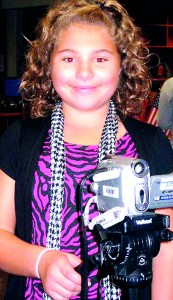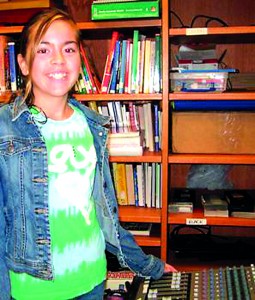Student Broadcasters capture headlines from the Hallways
View(s):In schools at all levels, students aren’t just studying the news, they’re reporting it! You’ll find them “on air” with school officials and community members as well as “anchoring” from behind a desk. The budding “Walter Cronkites” run the show from choosing a topic to scripting to filming and editing, offering proof that kids literally can make news. Teachers who work with these young broadcasters report that what students gain from the experience is immeasurable — self-confidence, insight, and a thriving interest in current events.Included: Find out what essential items you will need to start a broadcast journalism program.
“There are so many important skills, but the most important one for the broadcast club is confidence,” observes Rosemary Angelina. “Students who are shy and quiet may not want to be reporters [on day one]. But usually by December, I ask again about reporting, and they are happy to be asked and to have the chance to report. They do a great job. I think that this is so because they really wanted to report but did not feel confident, so they watched and learned.”
Another skill that students at Indian Lane Elementary School take away from their experience with the Broadcast Club is how to work as a team. A parent volunteer with a background in teaching, Angelina loves to watch the kids look out for one another, teach each other how to operate sound equipment, or help each other look up sports scores because a reporter left his notes at home.
When Angelina proposed the club to administrators, the school didn’t have a “studio” but did possess a modest broadcasting system. While they awaited an upgrade to allow all classrooms to view broadcasts, Angelina worked with interested students in grades three to five to develop interviewing skills and master the arts of recording and reporting. Before long, the Media, Pennsylvania, youngsters were poised to videotape the chorus concert.
 “Broadcasters walked around and asked questions to the audience about the concert,” Angelina recalls of their first foray into journalism. “They interviewed fellow classmates who were preparing for the chorus concert, and then interviewed them after the concert. It was a lot of fun and the kids did well.”
“Broadcasters walked around and asked questions to the audience about the concert,” Angelina recalls of their first foray into journalism. “They interviewed fellow classmates who were preparing for the chorus concert, and then interviewed them after the concert. It was a lot of fun and the kids did well.”
The concert led to other opportunities, such as announcing at the parent-staff basketball game. By the midpoint of the following school year, the studio (a section of the library) was prepared to host a live broadcast that could be carried in every classroom.
“The fifth grade broadcasters that year created the name for the broadcast: News on the Lane. Because of the popularity, the broadcast club became a club exclusively offered to fifth graders,” reports Angelina.
Indian Lane broadcasters present a live newscast each morning. When special announcements are made or guests appear, Angelina records the broadcast, edits it, and publishes the program online. She receives news and announcements from the school, and a parent volunteer types the material in preparation for the broadcast. Students who are scheduled to present the news get the material via email so that they can practice. They arrive at the library about 15 minutes before airtime to review, do sound checks, and make last-minute preparations.
Two reporters share the daily news, and a sports reporter appears three days per week. In order to give the sports report, broadcasters must write an original 30-second report and have it polished and ready by airtime.
NEWS ON THE LANE
“We start exactly at 9:00 a.m. when the bell rings. The sound crew starts our broadcast theme song, written by Jon Boyle, our band instructor. Then the reporters begin with, ‘Live from Indian Lane, it’s News on the Lane!’” shares Angelina. “The broadcasters state the date and ask everyone to stand for the pledge. Students from each class take a week to come on the broadcast to lead the pledge. Next there is a moment of silence, and then the students recite the Bobcat Pledge, Indian Lane’s anti-bullying pledge.”
The broadcast switches gears with the announcement of birthdays and other timely and relevant news — class trips, club meetings, and more. Students from other grades visit to promote bingo night and other events as they occur. During some special months, the broadcast includes features that celebrate poetry, geography, and Black history.
“If we have a Broadcast Club Community Chat, we ask the audience to continue to watch as we interview a special guest,” adds Angelina. “If a class cannot view it at the time, it will be available online later that day.” At the end the broadcast, the reporters sign off with a closing line such as the current favorite, “Go, Phillies!”
Broadcasters volunteer to take part in club chats, which are live interviews with community members. The extensive list of interviewees includes a radio reporter, a local librarian, a school board member, the district’s director of teaching and learning, the middle school principal, the middle school counselor, a farmer, the CEO of WAWA, a sketch artist for a police department, an artist, the local theater director, Congressman Joe Sestak, and others. When a supervisor of voting machines came to school, he explained how the machines operated and brought a voting booth. It was nearly Super Bowl weekend, so the students had the opportunity to vote for the team they expected to win. Community members autograph the club’s guest book when they have completed their interviews as a keepsake for the school.
“Being part of the broadcast club teaches students many life skills, especially coping and quick thinking. We are live, so anything can happen!” Angelina explains. “They do a great job of keeping the broadcast flowing and continuing with it no matter what happens.When a reporter doesn’t show at the last minute, someone jumps in and does it or the other reporter does it all, or when a camera cable cord gets bumped out, the sound person watching the broadcast on the monitor runs over to the camera and fixes it. No words are needed.”
With four years of experience behind her, Angelina knows the capabilities of budding reporters. It takes time for elementary students to become comfortable in front of the camera, so she has fourth graders join the seasoned fifth grade broadcasters as apprentices each April. The incoming club members learn stage presence and how to control their reactions on camera. A primary resource for the new team is the Broadcast Handbook created by Angelina, which describes the roles and responsibilities of Indian Lane broadcasters.
-Education World
Follow @timesonlinelk
comments powered by Disqus


